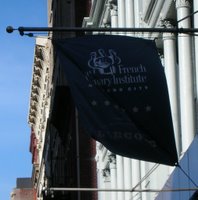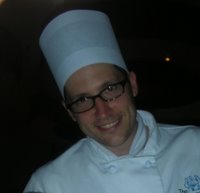DONKEY-TIME
 On the menu for dessert in the restaurant tonight was a Chilled Pudding With Candied Fruites (Vielle France) called the Diplomate. Chef A. was back with us in Pastry and I came to class thinking we'd be able to do a second dish, the Thursday dessert we wouldn't otherwise get the opportunity to make Snow Eggs With Honey and Pistachio (Ile De France), Oeufs A La Neige Au Miel Et Aux Pistaches.
On the menu for dessert in the restaurant tonight was a Chilled Pudding With Candied Fruites (Vielle France) called the Diplomate. Chef A. was back with us in Pastry and I came to class thinking we'd be able to do a second dish, the Thursday dessert we wouldn't otherwise get the opportunity to make Snow Eggs With Honey and Pistachio (Ile De France), Oeufs A La Neige Au Miel Et Aux Pistaches. DISH: Chilled Pudding With Candied Fruites (Vielle France), Diplomate
DISH: Chilled Pudding With Candied Fruites (Vielle France), DiplomateRECIPE: Preheat oven to 350F (375F convection oven). Gently heat 450 ml milk, 225 ml cream, and 1/2 a vanilla bean on the stove-top. Separately, whisk 3 whole eggs, 4 egg yolks, 100g sugar and a pinch of salt. Chop 50g liquorice stalks (angelica), 50g candied cherries, and 100g golden raisins and soak in 75 ml kirsch as long as possible. Remove vanilla bean from milk-cream mix and whisk a little at a time into the egg mixture, tempering til fully integrated. Chop day-old genoise, brioche, and croissants (you could use fresh cake too but this is a dessert that helps use up leftovers) into pieces about 3/4 inch squared and set aside in a bowl. Drain fruits of liquor and gently toss with cake cubes. Pour in a 1/3 of the custard mixture (egg-sugar-milk-cream mixture) and let sit a few minutes. Use pommaded butter or butter-spray to grease Diplomate dessert molds then without packing the molds fill them gently with the soaking cubes, piling them a little above the tops of the molds. Ladle custard into filled molds so that the cubes soak it up and the liquid reaches the lip.
Place molds in a hotel pan and pour heated water 3/4 way up molds. Cover pan loosely with aluminum foil and bake for 20 minutes. Lower temperature to 325F and cook until the cubes don't exude liquid when pressed. Remove from tray, allow to cool then tap the bottom of the mold and set aside on a rack until ready to serve.
BREAKDOWN: No pictures today but you're not missing much. The molds we used weren't the short, grooved molds that I've seen on the web but higher, smooth, tower molds. We plated two ladlefuls of creme anglaise into each bowl and placed the pudding in the center of it. There was no garnish or decoration and the dessert looked bare. We felt embarassed for its nakedness as it was sent out into the restaurant-- it could have used some type of chocolate, crisp cookie or reduced syrup.
I asked about doing the Snow Egg dessert and Chef said we could do it if we wished but that we wouldn't learn much from it. He suggested we make some cookies or sorbets instead but we couldn't quite pull together on it and I spent time trying to learn how the orders were expedited, that is how they are called out, kept track of and brought up to the station where the waiters take them to customers' tables. The person who expedites the dishes calls out orders, makes sure that the plate rims are free of fingerprints using a cheesecloth dipped in water and a splash of vinegar, but otherwise doesn't do much plating. I haven't done this full-time on any one night yet and with the Dean behind you in the front of the kitchen where meat and fish are cooked (Saucier and Poissonier) it's something of a rite of passage.
I had a bit of my own rite of passage in Patissier (Pastry) tonight though. Chef speaks with a bit of an accent. I'm not certain where he's from but his accent is somewhere between British and German. He's hit or miss personality-wise; sometimes friendly, sometimes, ahem, not. At one point when he asked for a plate, I couldn't determine whether he said, 'plate,' or 'plates,' so I handed him 3 just in case. Well, apparently that was the stupidest thing in the world to do because he called me a donkey. I've been called several things but I can't say one of them has been 'donkey.' It's a reminder that trading in the newspaper business for the kitchen has meant worse hours, worse money and somehow, even more diva-personality types!
One last item: I was introduced to a process tonight by a Level 4 student that might be fun to play with-- making fruit caviar using sodium alginate. He used the seaweed extract to coat drops of thickened fruit juice which then kept a jellied shape on the outside and stayed juicy on the inside. I'm not quite sure how I'd integrate it into a dessert but it's certainly another interesting aspect to the food chemistry and technology, or molecular gastronomy that I'd read about a few months ago but would like to learn more about.





0 Comments:
Post a Comment
<< Home